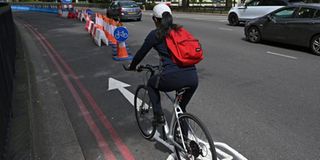We need safe walkways, bicycling lanes

What you need to know:
Pedestrians and cyclists across the continent form a big number of commuters and cycling for many is an affordable option
The problems that we are facing in the world today like pandemics, pollution, wars, and climate change are too complex and require sustainable solutions.
They cannot be solved by one entity but rather through collective action from governments, universities, industry, and citizens. The fuel crisis, which has affected many countries, is one of those that should cause a paradigm shift in the transport systems across Africa, because therein lies a big opportunity in dealing with the fuel and population growth crisis.
Pedestrians and cyclists across the continent form a big number of commuters and cycling for many is an affordable option.
A bicycle is a household item in many rural and semi-urban communities in Africa.
Household surveys that use the relative poverty measure show that owning a bicycle is treated as being of better economic status. A single bicycle costs about $100 and can last for years. The only thing we need now is bicycling ways to tap this potential, cope with fuel crises, improve health and reduce carbon emission, among many other benefits. This can only be achieved with safe walkways and bicycling lanes.
Walking and bicycling have always been a norm for many Africans. Many of us can testify to having walked for miles to school during your lower primary education.
As we grew older and had access to money, owning a car and driving became a priority. I have
nothing against owning a car, but I have a problem with not having an option, if you chose not to drive, or preferred to walk or ride a bicycle.
The lockdowns that were imposed as a measure of reducing the spread of Covid-19 in many countries, showed us the value of having a functional walkway and owning a bicycle. Today, the high costs of fuel have forced many motorists to park their cars and opt to walk. Yet the cost of fuel keeps increasing.
We must understand that oil is finite and that the only way to deal with the crisis now and in the future is to opt for more sustainable and environmentally safe solutions. It is no brainer that walking and cycling are both sustainable and eco-friendly.
By extension, the benefits go beyond the environment and reflect in the health of the people who through exercise reduce the danger of sedentary lifestyles that have been responsible for the increase in the risk of cardiovascular diseases, diabetes, obesity, depression, and anxiety, among other diseases.
As a cycling enthusiast, I cannot stop wondering why we do not have basic walkways and cycling lanes in places where they are most needed.
Why pedestrians and cyclists risk their lives is because they have no choice, but to share roads with motorists. Why, even when budgeted for, walkways are not given the quality and attention that they deserve during road construction and why most motorists do not respect cyclists and pedestrians as road users with an equal stake. The whys are way too many and I don’t know if anyone has a convincing response to them.
We obviously need to learn a thing or two from places such as Lango, Teso and West Nile where bicycling is the norm and a common mode of transportation.
Bicycles are used for business (original ‘boda boda’), shopping, fetching water and going to school, for those who can afford them. Away from home, the Dutch consider cycling a respectable mode of transport and the Netherlands has over the years designed its transport system to accommodate and protect cyclists. We need to benchmark on that and plan for not only motorists but cyclists and pedestrians in our various towns and cities.
Maureen Agena
Development Communications Specialist
Twitter: maureenagena




